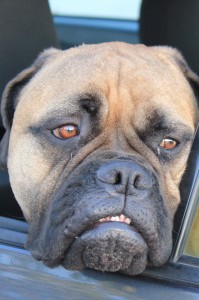 Beauregard (TTA SURGERY) tore his right CCL when he was about 8. The vet verified the CCL damage and sent us to a surgeon in the Phoenix area. Post surgery recovery was good with no limping or other signs of discomfort after about five to six weeks.
Beauregard (TTA SURGERY) tore his right CCL when he was about 8. The vet verified the CCL damage and sent us to a surgeon in the Phoenix area. Post surgery recovery was good with no limping or other signs of discomfort after about five to six weeks.
A year later he tore his left CCL going after a ball. Same story, same surgeon. This time, although he seems to be able to walk normally, he has a pronounced limp when he gets up from a prone position. The limp goes away as he continues to walk. The big problem is that he seems to be losing control of his back legs. Sometimes he will cross the two legs and nearly trip and fall. He gets around okay and even takes short walks but is almost 13 years old now and is much slower than he was before his surgeries.
I know he’s getting older but the apparent loss of control in his rear legs concerns me. It doesn’t seem to be getting any worse but I’m wondering what the cause is. His knees were recently x-rayed and the vet didn’t see any problems with the TTA repairs. Any ideas?
As the vet didn’t discover new problems, lets assume he needs muscular redevelopment. Are there animal PT centers inyour area? This would seem the most viable solution. Did you have some form of physical therapy immediately post op? It sounds as if he may have weak or atrophied adductor muscles, the ones that bring the leg forward. Also, his large thigh muscle is the last and most difficult to rebuild are likely also quite weak if he’s crossing the legs over and tripping himself up.
The sartorius muscle lies at the front of the thigh. It is a thin ropelike muscle. My PT had me doing daily deep tissue massage, during the 6 month recovery. I began by running my fingers deep along the back and down the side of the leg. Then, using my thumb and forefingers, I stroked down the sartorious first. Then I did the same for the muscles at the rear, gliding nad massing the back of he thigh, both top and underside with the “V” of the hand thimb anf forefingers. Then I’d work on massaging the length of the biceps femoris, starting at the back of the leg (near the tail, but on the side of the thigh) drawing diagonally to the front of the knee. In the back of the knee, are the abductor muscles… the ones that bend the knee, which also need to be included in the massage.
My PT had me do the massage before walking the dog, on lead. Walks were twice a day, beginning at 5 minutes each and gradually working to 30. If you can get this much done for the next 4 months or so, you may see some improvement.
If he is so weak he can not keep from crossing his back legs, you may need to support him physically. Slings will work. I’ve recently come accross a state of the art product called “help ’em up”! It straps around the dog and gives you easy handles. You can use both the front and back segments separately or together. Your dog needs to walk.
If you do have a PT center, with an underwater treadmill, fabulous! I would imagine a bit of building up those muscles would have to preceed any swimming.
Losing control of hind legs is certainly a concern. Muscle wasting could be one reason, I assume your vet would notice that and point it out though? Muscle mass assessment and development would be a place to start.
However, I would be concerned that it could be a spinal issue and I would bring that up to the vet and have it investigated.
I agree with the above – PT, massage therapy and other rehab should definitely be pursued, as well as supportive measures to help Beauregard get around while the exact cause of the weakness is determined. Unexplained, sudden weakness is definitely a cause for concern. As Jana asked, has your vet looked into spinal issues at all??
Let us know how things turn out 🙂
I would find a board certified neurologist (teaching hospital). We had a lab (12 yrs old) with similar symptoms and he was diagnosed with compression myelopathy. Basically, he had a couple of vertebrae which were compressed and causing damage to some nerves; the result was numbness/lack of feeling in his back legs. There are surgical options, but it was not an option for our dog because he had other medical issues but we got him a wonderful wheelchair and he had a couple more great, active years!